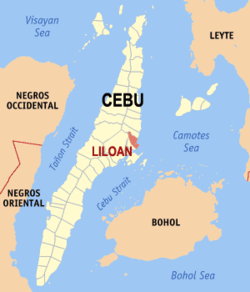Liloan | |
|---|---|
| Municipality of Liloan | |
 From Suba bridge | |
| Etymology: Cebuano term lilo, meaning whirlpool | |
 Map of Cebu with Liloan highlighted | |
Location within the Philippines | |
| Coordinates: 10°24′40″N123°58′56″E / 10.41111°N 123.98222°E | |
| Country | Philippines |
| Region | Central Visayas |
| Province | Cebu |
| District | 5th district |
| Founded | 1845 |
| Barangays | 14 (see Barangays) |
| Government | |
| • Type | Sangguniang Bayan |
| • Mayor | Aljew Fernando J. Frasco |
| • Vice Mayor | Darwin T. Apas |
| • Representative | Vincent Franco D. Frasco |
| • Municipal Council | Members |
| • Electorate | 87,305 voters (2025) |
| Area | |
• Total | 45.92 km2 (17.73 sq mi) |
| Elevation | 20 m (66 ft) |
| Highest elevation | 231 m (758 ft) |
| Lowest elevation | 0 m (0 ft) |
| Population (2024 census) [3] | |
• Total | 158,387 |
| • Density | 3,449/km2 (8,933/sq mi) |
| • Households | 37,390 |
| Economy | |
| • Income class | 1st municipal income class |
| • Poverty incidence | 18.81 |
| • Revenue | ₱ 641.4 million (2022) |
| • Assets | ₱ 1,320 million (2022) |
| • Expenditure | ₱ 560.6 million (2022) |
| • Liabilities | ₱ 576.1 million (2022) |
| Service provider | |
| • Electricity | Visayan Electric Company (VECO) |
| • Water | Metropolitan Cebu Water District (MCWD) |
| Time zone | UTC+8 (PST) |
| ZIP code | 6002 |
| PSGC | |
| IDD : area code | +63 (0)32 |
| Native languages | Cebuano Tagalog |
| Website | www |
Liloan, officially the Municipality of Liloan (Cebuano : Lungsod sa Liloan; Tagalog : Bayan ng Liloan), is a municipality in the province of Cebu, Philippines. According to the 2024 census, it has a population of 158,387 people, [5] making it the most populated municipality in Cebu and the whole Visayas.














